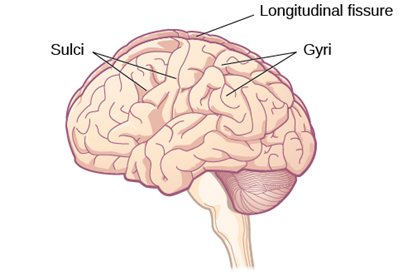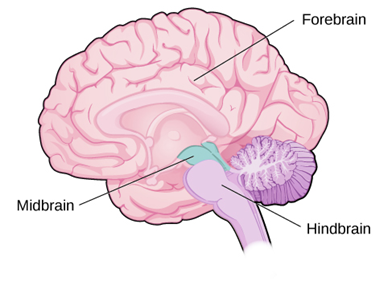4.3: Structures of the brain
- Page ID
- 139778
Brain Structures
The surface of the brain, known as the cerebral cortex, is very uneven, characterized by a distinctive pattern of folds or bumps, known as gyri (singular: gyrus), and grooves, known as sulci (singular: sulcus), shown in Figure \(\PageIndex{1}\). These gyri and sulci form important landmarks that allow us to separate the brain into functional centers. The most prominent sulcus, known as the longitudinal fissure, is the deep groove that separates the brain into two halves or hemispheres: the left hemisphere and the right hemisphere. [1]

The two hemispheres are connected by a thick band of neural fibers known as the corpus callosum, consisting of about 200 million axons. The corpus callosum allows the two hemispheres to communicate with each other and allows for information being processed on one side of the brain to be shared with the other side. [1]
The two hemispheres of the cerebral cortex are part of the forebrain (see Figure \(\PageIndex{2}\)), which is the largest part of the brain. The forebrain contains the cerebral cortex and a number of other structures that lie beneath the cortex (subcortical structures): the thalamus, the hypothalamus, the pituitary gland, and the limbic system. The cerebral cortex, which is the outer surface of the brain, is associated with higher-level processes such as consciousness, thought, emotion, reasoning, language, and memory. Each cerebral hemisphere can be subdivided into four lobes, each associated with different functions. [1]

[1] “The Brain and Spinal Cord” on OpenStax is licensed under CC by 4.0
[2] “The Brain and Spinal Cord” on OpenStax is licensed under CC by 4.0
[3] Image from “The Forebrain Structures” on OpenStax is licensed under CC by 4.0

